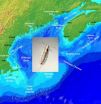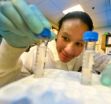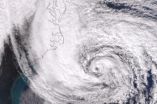(Press-News.org) Standing in a full-body scanner at an airport isn't fun, and the process adds time and stress to a journey. It also raises privacy concerns. Researchers now report in ACS' The Journal of Physical Chemistry Letters a more precise and direct method for using that "terahertz" (THz) technology to detect explosives from greater distances. The advance could ultimately lead to detectors that survey a wider area of an airport without the need for full-body scanners.
R. Kosloff and colleagues explain that using THz spectroscopy by itself is challenging for sensing far-away explosives. This technology uses beams of electromagnetic radiation that lie between microwaves, like those used in kitchen ovens, and the infrared rays used in TV remote controls. In addition to screening people for explosives, it is used at drug companies for quality-control purposes and, most recently, to study the layers of paint of ancient works of art. With recent advances, the technique is becoming a strong candidate for detecting substances from a distance. Other researchers have developed remote-sensing THz instruments, but they combine it with a second method to identify substances. Kosloff's group aimed to use THz directly to eventually develop even better remote sensors.
They developed a computational tool and used it to successfully identify two explosives, RDX and TATP, with THz data directly. RDX is a component of plastic explosives, and TATP is an explosive found in the shoes of the "shoe bomber" in 2009. "The ability to perform experimentally and simulate multidimensional spectroscopy should significantly enhance the screening ability of THz spectroscopy," say the researchers.
INFORMATION:
The authors acknowledge funding from the U.S. Department of Homeland Security.
The American Chemical Society is a nonprofit organization chartered by the U.S. Congress. With more than 161,000 members, ACS is the world's largest scientific society and a global leader in providing access to chemistry-related research through its multiple databases, peer-reviewed journals and scientific conferences. Its main offices are in Washington, D.C., and Columbus, Ohio.
To automatically receive news releases from the American Chemical Society, contact newsroom@acs.org.
Follow us: Twitter | Facebook
Better remote-sensing explosive detectors: The beginning of the end of full-body scanners?
2014-02-26
ELSE PRESS RELEASES FROM THIS DATE:
Caffeine-based gold compounds are potential tools in the fight against cancer
2014-02-26
The side effects of ingesting too much caffeine — restlessness, increased heart rate, having trouble sleeping — are well known, but recent research has shown that the stimulant also has a good side. It can kill cancer cells. Now, researchers report in the ACS journal Inorganic Chemistry that combining a caffeine-based compound with a small amount of gold could someday be used as an anticancer agent.
Angela Casini, Michel Picquet and colleagues note that caffeine and certain caffeine-based compounds have recently been in the spotlight as possible anticancer treatments. ...
MSU advances algae's viability as a biofuel
2014-02-26
EAST LANSING, Mich. — Lab success doesn't always translate to real-world success. A team of Michigan State University scientists, however, has invented a new technology that increases the odds of helping algae-based biofuels cross that gap and come closer to reality.
The current issue of Algal Research showcases the team's invention — the environmental photobioreactor. The ePBR system is the world's first standard algae growing platform, one that simulates dynamic natural environments.
Simply put, ePBR is a pond in a jar that helps identify, cultivate and test algal ...
Where have all the codfish gone?
2014-02-26
The mega-decline in cod and other fisheries across the North Atlantic Ocean threatens the livelihood of fishermen and communities in New England and Atlantic Canada. One suspect in the disappearance of cod and other groundfish is the food source for their young: a planktonic copepod crustacean, no larger than a grain of rice. Recent changes in local copepod populations have co-occurred with declines in fisheries elsewhere, such as the collapse of the cod fishery in Europe's North Sea.
For this and other reasons, Petra Lenz and Andrew Christie are among the scientists ...
Exercise, surgically removing belly fat improves cognition in obese, diabetic mice
2014-02-26
Augusta, Ga. – Cognitive decline that often accompanies obesity and diabetes can be reversed with regular exercise or surgical removal of belly fat, scientists report.
A drug already used to treat rheumatoid arthritis also helps obese/diabetic adult mice regain their ability to learn and comprehend, while transplanting belly fat to a normal mouse reduces those abilities, said Dr. Alexis M. Stranahan, neuroscientist at the Medical College of Georgia at Georgia Regents University.
Studies in humans and animals indicate that obesity and diabetes – which often go hand ...
WSU researchers say fear of death may curb youthful texting and driving
2014-02-26
PULLMAN, Wash.—While drivers tend to believe it is dangerous to text and drive, many say they can still do it safely. Now Washington State University researchers say drivers can be discouraged from the practice with public service announcements that evoke their fear of death in graphic terms.
Looking to curb what former U.S. Transportation Secretary Ray LaHood called "a national epidemic," WSU marketing professors Ioannis Kareklas and Darrel Muehling recently explored driver attitudes toward texting. They examined various ways to discourage texting while driving through ...
Software maps ambiguous names in texts to the right person
2014-02-26
This news release is available in German.
If a name is ambiguous and given without context, even humans struggle. When reading the last name "Merkel", people do not know if it refers to the Chancellor of Germany Angela Merkel or the famous soccer coach Max Merkel. It is a drawback for web search, too. Up to now, the programs can capture character strings like "Angela Merkel", but they do not pay attention to attributes like "German Chancellor" or "Germany's First Lady" at all. Even worse, after the word "Merkel" is entered, the search engines provide information about ...
Offshore wind farms could tame hurricanes before they reach land, Stanford-led study says
2014-02-26
For the past 24 years, Mark Z. Jacobson, a professor of civil and environmental engineering at Stanford, has been developing a complex computer model to study air pollution, energy, weather and climate. A recent application of the model has been to simulate the development of hurricanes. Another has been to determine how much energy wind turbines can extract from global wind currents.
In light of these recent model studies and in the aftermath of hurricanes Sandy and Katrina, he said, it was natural to wonder: What would happen if a hurricane encountered a large array ...
Research: Fructose not responsible for increase in non-alcoholic fatty liver disease
2014-02-26
TORONTO, Feb. 26, 2014—Non-alcoholic fatty liver disease is the most common chronic liver disease in developed countries, affecting up to 30 per cent of their populations.
Since the disease is closely linked to obesity and Type 2 diabetes, there's a growing debate in the medical community about whether diet plays a role in its development, specifically the consumption of fructose.
The possible link to non-alcoholic fatty liver disease has become the main criticism against fructose among those who believe there is something unique about the fructose molecule or the way ...
Climate change causes high, but predictable, extinction risks
2014-02-26
Judging the effects of climate change on extinction may be easier than previously thought, according to a paper published today in the journal Nature Climate Change.
Although widely used assessments of threatened species, such as the IUCN Red List, were not developed with the effects of climate change in mind, a study of 36 amphibian and reptile species endemic to the US has concluded that climate change may not be fundamentally different from other extinction threats in terms of identifying species in danger of extinction.
The new study, funded by NASA and led by Richard ...
Taming hurricanes
2014-02-26
Wind turbines placed in the ocean to generate electricity may have another major benefit: weakening hurricanes before the storms make landfall.
New research by the University of Delaware and Stanford University shows that an army of offshore wind turbines could reduce hurricanes' wind speeds, wave heights and flood-causing storm surge.
The findings, published online this week in Nature Climate Change, demonstrate for the first time that wind turbines can buffer damage to coastal cities during hurricanes.
"The little turbines can fight back the beast," said study ...





